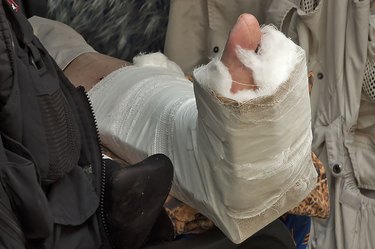
With 26 bones in the foot, a fracture or break to any of them can require medical treatment and immobilization of the entire foot to allow the bone to heal. Depending on the severity of the injury, you may be required to wear a protective boot or cast that may necessitate the use of crutches or a cane. While initially challenging, you can learn to use the walking aid to climb stairs if necessary.
Identification
Video of the Day
A broken foot bone results from a traumatic fracture or a stress fracture, according to the American College of Foot and Ankle Surgeons' website Foot Health Facts. While traumatic fractures usually result from a direct blow to the foot, stress fractures result from repetitive activity over time. Certain health conditions such as osteoporosis can predispose you to stress fractures. A broken bone in the foot can cause pain, swelling, bruising and difficulty placing weight on the foot, making it hard to walk or climb stairs. Proper diagnosis by a physician through X-rays or an MRI of the foot is required to determine the correct course of treatment.
Video of the Day
Treatment and Stairs
Immobilization is the primary treatment for a broken bone in the foot. Your foot may be placed in a cast or you may be given a removable brace or rigid shoe that protects the foot when walking. In some cases surgery may be necessary to set the bone in place with a pin or screw, so that it can heal properly. Consult with your doctor to determine if you can place any weight on the foot during the healing process. If you can place some weight on the foot, use a cane to help you navigate stairs. Hold the railing in one hand, climb a stair with your good foot, then follow it by leaning on the cane along with your injured foot.
Crutches
A broken bone in the foot that results in a cast will require the use of crutches to walk, keeping all weight off of your injured foot. To climb stairs using crutches, place both crutches under one arm and hold the railing with the hand of your other arm. Pushing down on the crutches and the railing, hop up with the good leg and follow with the injured one, placing the weight on the crutches rather than the foot, according to the Lucile Packard Children's Hospital at Stanford. Take the stairs slowly and avoid climbing stairs in fast-moving crowds with crutches. In cases where there is no railing, keep a crutch under each arm as you normally would.
Warnings
Remove throw rugs from any stairs or stairway landings as these items can slide, causing you to lose your footing, recommends the American Academy of Orthopaedic Surgeons. Ensure that stairways and railings are dry to prevent slipping or losing your grip on the railing as you climb the stairs. Wear flat shoes with nonslip soles that will not slide on the stairs. Avoid using an escalator with crutches, as your foot or crutch can easily become trapped in between or to the side of the moving stairs. When possible, opt to take an elevator with crutches.